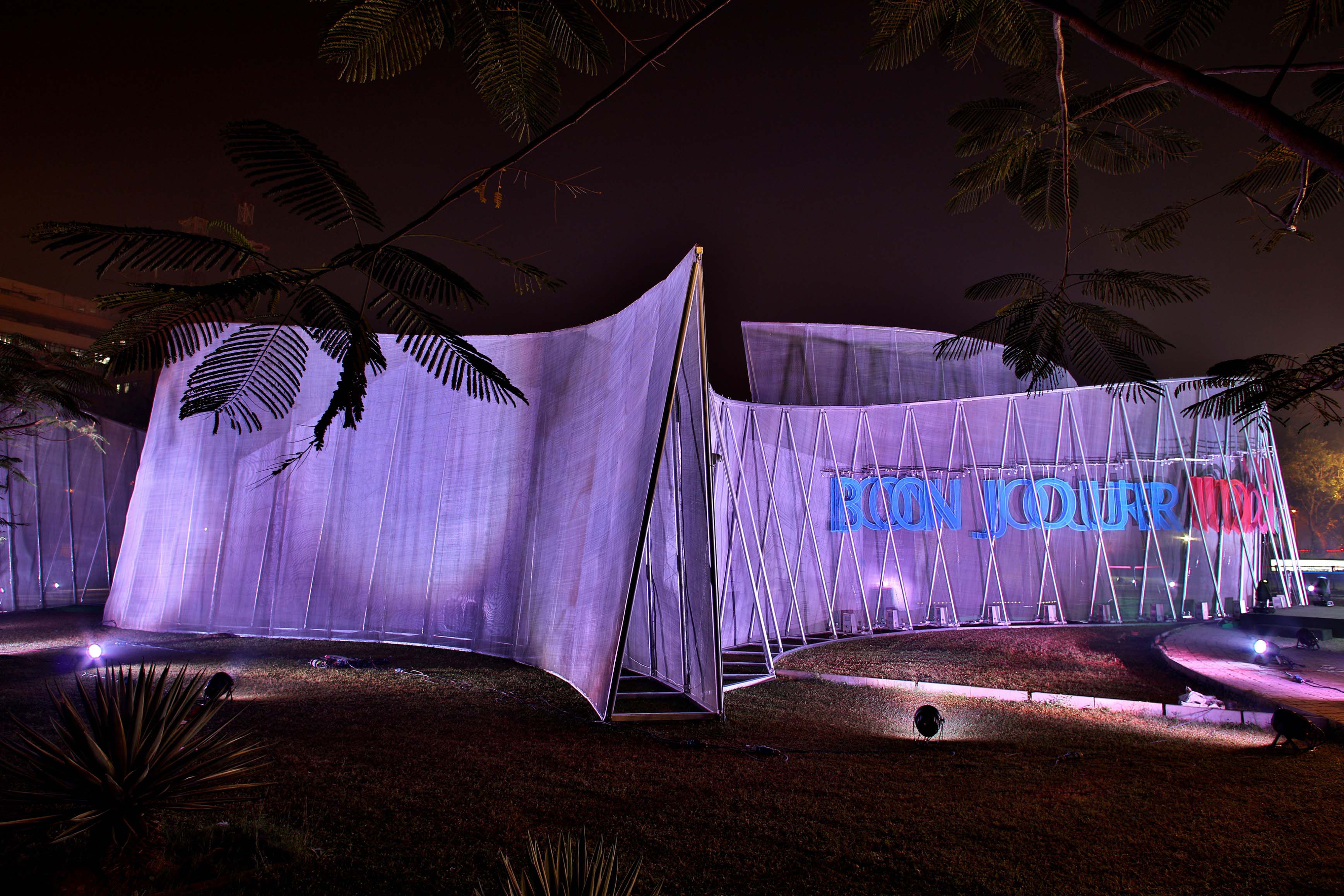The ‘Bonjour India Experience’ was the flagship initiative of the Bonjour India 2017-2018, a festival which celebrated Indo-French collaborations through more than 300 events spread over four months across 33 Indian cities. At the heart of the festival, The Bonjour India Experience pavilion was a one-of-its-kind travelling exhibition at the intersection of art, architecture, design and urbanism. The 9 meter high, 800 square metre and 40 tonne installation travelled approx. 3500 kilometres from the iconic India Gate in Delhi to Cross Maidan Garden behind the historic Churchgate Station Mumbai to become the star attraction of the world’s largest book fair in Kolkata over a period three months. It welcomed more than 180,000 visitors over a period of 30 odd days spread over the three cities.

One of the first decisions jointly taken by the clients and the design team lead by SpaceMatters was to locate the pavilion in public urban spaces. While this may seem like an obvious choice, similar cultural events in India have been largely confined to institutional spaces such as museums and cultural centres. Often perceived as elitist, these spaces cater to a small segment of the population and their ambience is in stark contrast to the diverse energy of the urban public space in Indian cities. As cultural events retreat into gated zones the access to public space in Indian cities is also shrinking, increasingly being policed and monetised. Thus, when asked to suggest an appropriate public space in their city, associates initially suggested commercial malls! The call to locate the pavilion in truly public urban spaces presented countless challenges and it was a complex undertaking to navigate the maze of permissions needed to mount an installation of this scale in a public location. However, its interaction with the urban context became the defining characteristic of the pavilion and was instrumental to its success.
The design had to balance the functional demands of a travelling pavilion with the stringent requirements of a sealed exhibition space required to safely house expensive audio visual equipment while creating create a comfortable environment for the visitors. The pavilion had to be designed to be installed in a week and dismantled in three days in crowded public spaces without the use of heavy machinery (prohibited at the high security sites); with the ease of travelling halfway across the country and adapting to new sites. To reconcile the mobile and temporal nature of the pavilion alongside the ambition to leave a memorable mark on the cities it travelled to, the pavilion had to create an iconic visual presence combined with a lightness of being.
The thematic focus of the Bonjour India festival was ‘Creativity, Innovation and Partnership’ between India and France. Embodying these themes, the form of the pavilion evolved from the idea of confluence, with 6 curves rising together to embrace three pavilions that highlight various aspects of Indo-French creativity, innovation & partnership. The metal curves, arranged in a modular symmetry spiralling out from a central core, consisted of a rhythmic arrangement of staggered, self-supporting steel members draped with 20,000 square feet of hand woven steel mesh. The massive self-supporting structure is designed down to the last joint to be flat packed and largely hand installed in the shortest possible time. Combining the precision of cutting edge engineering and unique expression of craft, the design pays homage to the ingenuity and abstraction that is the hallmark of both French and Indian architecture.
As an intervention in public space the pavilion is designed to integrate itself with the site conditions at each location. The metal members and mesh provide for varying gradations visual permeability, allowing the structure to weave into the urban surroundings, both emerging from and merging into the context. Views of iconic monuments at each site, such as the India Gate in Delhi and the Churchgate Railway Terminus in Mumbai are framed within the layered silhouette of the structural contours and wire mesh. As the pavilion transforms with the play of light through day and night, its spiralling form becomes the pivot which reorganises the nature of the urban open area while heightening curiosity amongst those outside to explore within. Twisting and turning, rising and falling from a height of 4 metres to 9 metres across its perimeter, the sculptural form of the pavilion transforms with motion as the visitors walk around it and into it.
The heart of the pavilion is an immersive journey through the unfolding story of collaboration between the two countries across various fields. The diversity and depth of these partnerships is not well known to the general public, and largely even to experts beyond their own domains. A five month long intensive research process generated a wealth of content relating to diverse fields – literature, fashion, art, aviation, space , cinema, climate change, urbanism and gastronomy, to name only a few. This presented a new challenge for curation. How does the exhibition make diverse information accessible to an equally diverse audience – varying in age, linguistic preferences, educational background, and ranging from informed Francophiles to curious passer-by’s? Instead of an overarching narrative, the exhibition provided the visitor with different choices for a multifaceted experience based on individual interests. The visitor was therefore envisioned as an active participant, instead of a passive observer.
For this an immersive environment was conceived through both physical and virtual space, interpreted in the tradition of classic ‘dioramas’ with the added dimension of interactive technology and augmented reality. Combining sound and light, optical illusion and augmented reality, tactile and virtual, the pages of books and the pixels of LED screens, the exhibition creates an atmosphere of wonder and discovery, provoking a playful sense of curiosity in the visitor. The design that emerged from these explorations consisted of layered narratives woven together in the form of three continuous yet distinct spatial experiences, intersecting at the core. These three spaces were named the Creativity, Innovation and Partnership galleries corresponding to the festival theme.
The visitor first steps into the Creativity gallery. The space is conceived as a Dadaist expression of a Parisian square, the blurring of spatial boundaries accentuated with trompe l’oeil imagery, multimedia and interactive installations. Here, the visitor encounters and interacts with narratives of Indo-French collaboration in the fields of literature, performing arts, cinema and fashion. The Innovation gallery portrays the shrinking distances and expanding horizons of the bilateral relations, as the two countries collaborate in building sustainable cities and communities, preserve shared built and natural heritage, jointly meet the challenges of climate change and explore new frontiers in space. A large scale augmented reality installation documents the timeline of these developments, allowing the visitor to literally see oneself as part of the shared history. The concluding Partnership gallery invites the visitor to become a part of the story. Education, gastronomy, travel are few of the aspects presented in this gallery through playful, digitally responsive interactive installations, engaging audiences of different ages and interests. An open-to-sky central space ties the three galleries. This space represents the strong sense of cross-pollination in the interpretation of the three themes as each of these ideas are always present in consonance with the other two – true innovation is at the confluence of creativity and partnership, and so on.
At various points in the exhibition, multimedia art installations help shift the visitor experience from information to abstraction, capturing the essence of exchange between two distinctive cultures. The kinetic signage installations, created in collaboration with Ant Studio, combines typography with technology to create a playful interface with the surroundings. The popular installation by French artists Scenocosme captures the sense of discovery, poignancy and awkwardness of cultural initiation using interactive and augmented reality technology. The finale of the exhibition, a collaboration with the Indo – French artist collective Mosquito Massala, called the Triptych Tales combines sound, visual imagery and physical space in a pulsating, high energy immersive experience. Triptych Tales brings together the combined talents of visual and musical artists from India and France, including Dualist Inquiry, Chinese Man, Nirmal Sapera, Talab Khan Barna and Lucid Raaga among others
The Bonjour India Experience pavilion was an outcome of possibly one of the largest and most diverse collaborations between India and France involving artists, writers, filmmakers, musicians, designers, artisans, builders, researchers, institutions, corporations, academicians, publishing houses, architects and many others. Almost 360 people were involved in the realisation of the pavilion in various capacities. There were various collaborations on the exhibition installations and multiple content partners including the Corbusier Foundation, Musée Yves Saint Laurent, Agence Française de Développement, La Fondation Louis Vicat, Archives SONUMA, Tata Central Archives, Institut Lumière amongst others. The Bonjour India Experience brought together content and talent from both countries which was presented to a diverse audience of from busloads of school children on their first ever trip to Delhi, to writers from France on their first trip to India, from ministers to picnicking families and strolling couples. In the visitor book, people often remarked at the pleasure of encountering the unexpected on an ordinary day, the joy of a whirlwind journey to a new culture on the way to the everyday commute to work, the discovery of new land and language, and the rediscovery of new aspects of our own shared history. Reaffirming the power of carefully produced and generously accessible space to tell our shared stories, the project embodied the Bonjour India themes of creativity, innovation and partnership between India and France in its process and outcome.
Project Facts
- Project Name: The Bonjour India Experience.
- Project Description– An immersive travelling exhibition and pavilion highlighting Indo- French relations and collaboration across disciplines.
- Client : Institut Français en Inde, The Embassy of France , India.
- Project Brief:
- Curation – Research and Content Development, Curation
- Design – Pavilion Design, Experience Design, Exhibition Design
- Project Management and Coordination
- Location: India Gate (New Delhi), Cross Maidan Garden (Mumbai), Salt Lake Central Park (Kolkata)
- Project Year: travelling pavilion open to public for approximately 10days each in three cities between November to February in 2017-2018.
- Indoor Exhibition Area: 4000 sq.ft.
- Pavilion area: 8000 sq.ft.
- Research: SpaceMatters and Institut Francais en Inde.
- Curation: SpaceMatters and Institut Francais en Inde.
- Design: SpaceMatters
- Project Management : SpaceMatters
- Executing Agency: RK Engineering (External Pavilion), Paras Art Studio (Exhibition), and Shivam Video – Audio Visual Equipment.
- Project Team SpaceMatters: Amritha Ballal ( Principal ) and Suditya Sinha ( Principal), Divya Manaktola ( Project Architect ) and Nishita Mohta (Project Architect) , Gaurav Gupta, Sony Joshua, Pulkit Mogha, Devansh Mahajan, Sandeep Singh Rathore, Girisha Sethi , Akhilesh Yadav, Kulvinder Singh (Structural consultant)
- Partners – Institut Francais en Inde, The French Embassy in Delhi, Alliance française de Delhi, Alliance française de Bombay, Alliance française du Bengale
- Content-creation collaborators: Rajat Nanda, Achint Jain, Vivan Kamath, Moulshri Joshi, Hemant Kumar
- Installation Collaborators: Ant Studio – Dynamic Signage Installation; Scenocosme – Rencontres Imaginaires Installation Art; Mosquito Massala – MandaLiterature, Tryptich Tales Video Installation Art; TaggLabs
- Content partners: Agence Française de Développement, Air France, ATA Architects, Archives SONUMA, Arianespace, Association des Amis de Lanza del Vasto, Atout France, Campus France, Chanakya International, Château de Versailles, Consulat Général de France à Pondichéry, Core Econ, DC Books, Diane de Selliers, Fata Morgana Editions, FIND Foundation, Fondation Le Corbusier, Fondation Pierre Bergé – Musée Yves Saint Laurent Paris, Full Circle Publishing, Green Books, La Fondation Louis Vicat, Lesage Interieurs, Malraux.org, Mapin Publishing, Musée Goupil – Bordeaux, Neemrana Music Foundation, Om Books, SNCF Group, the Raza Foundation, Institut Lumière, Gallimard, Institut français de Pondichéry, Niyogi Books, Rajpal & Sons, Seagull Books, Tata Central Archives, Thadagam Publishers, Vani Prakashan, Veolia, Warum Publishers, Young Zubaan,Dualist Inquiry, Chinese Man, Nirmal Sapera, Talab Khan Barna, Lucid Raaga, Talab Khan Barna , Ahmad Zahir, Viveick Rajagopalan & Naviin Gandharv
- Photographs: Hemant Chawla, Achint Jain, Nishita Mohta, Suditya Sinha
- Products : Asian Paints, Nilaya wallpaper, Phillips light, Losberger Tents, 3M reflective Film, Daikin Air Conditioners, Samsung Video Walls


























































